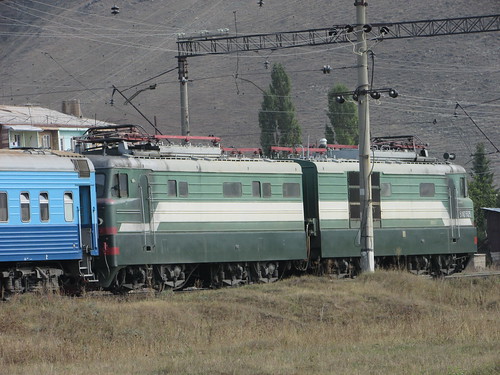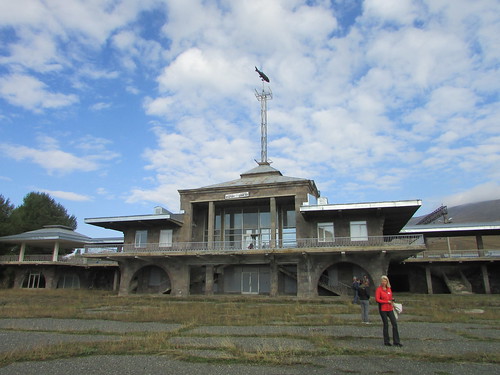With our train standing in the platform at the derelict-looking Tsovagyugh station, breakfast was served in the two dining cars starting at 07:30, local time. Both dining cars have two clocks, one set to 'Local' time, the other to 'Moscow' time.

The 'Golden Eagle' train: One of two Restaurant Cars.
The make-up of the train depends upon the tour being operated and the loading. Up to Baku (where I left the train) the make-up was 17 vehicles:-
Generator CarThe day started dry but cool. We made our way from the train onto the single crumbling platform, giving me my first view of the locomotive which had brought us from Yerevan - a Russian-built 2-section electric.
Staff Car
Coach 1 (Silver class)
Coach 2 (Gold class)
Coach 3 (Gold class - my coach)
Coach 4 (Gold class/Imperial)
Coach 5 (Gold class/Imperial)
Bar Car
Restaurant
Kitchen
Restaurant
Coach 6 (Gold class)
Coach 7 (Gold class)
Coach 8 (Silver class)
Coach 9 (Silver class)
Coach 10 (Silver class)
Staff Car

Armenia Railways: The Russian-built 3 kV d.c. 2-section locomotive which hauled the 'Golden Eagle' from Yerevan.
The station building was a once-impressive concrete affair with a steel lattice tower topped with a steel fish. We descended to road level via steps and joined our tour buses at a large, abandoned-looking station forecourt of fractured concrete with prolific weeds and the occasional cow-pat.

Armenia Railways: Tsovagyugh station, road side.
Our buses made a short drive on a main road around the periphery of Lake Sevan (a main road with a herd of cows wandering along, foraging for reasonable grass) to a promontory called The Peninsula. Originally an island, it became connected to land after the disastrous drop in lake water level following the introduction of a large number of cascaded hydro-electric plants fed from the lake by the Soviet Union.
A tough climb to the monastic churches of Sevanavank at the peak of the peninsula followed. This involved over 200 stone steps with a handrail provided either left or right (at least, most of the way) as the path zig-zagged up the hillside. The views of the lake at the top justified the climb and there were two old churches to explore.

Lake Sevan, Armenia: View across the lake from the Churches on the Sevanavank Peninsula.

Lake Sevan, Armenia: St. Arakelots Church, Sevanavank.
I found descending not bad at all and after passing through a market of souvenir traders, I explored the lake edge where there were a number of cafes and jetties with trip boats offering 20 minute cruises. Rejoining the buses, we drove back along the road to Tsovagyugh station, pausing briefly for Golden Eagle staff to take a group photograph of their passengers at a viewpoint at the lakeside. We then made a toilet stop at a modern supermarket/café complex where we were given generous samples of fresh baked ‘thin bread’ and a sort of baguette filled with cheese. I found both delicious.
Just before Tsovagyugh, we turned off on the road which ran through rolling hills towards Dilijan. A road tunnel over one mile long emerged into a heavily wooded valley which I christened the ‘enchanted valley’. A number of passengers commented on the sudden change in scenery. Our guide, Dmitri, said that ‘jan’ was a special term of affection which he rendered as ‘heart of my soul’ suggesting that Dilijan and its setting is very dear to the Armenian people.

Dilijan, Armenia.
Our next visit was to the Haghartsin Monastery, hidden in the deeply wooded mountains reached by a steep, winding road. The buses had to park about half a mile short of the monastic complex and it transpired that we were to walk the rest of the way, walking on the road which became too difficult for large buses. I say 'transpired' because, although I'd enquired, I could get no sensible answer about the length and difficulty of the walk. Well, I set off optimistically but found the walk taxing. Fortunately, a small bus had been provided to accommodate those who didn't wish to attempt to walk and, when this caught up with me, I gratefully 'hitched a ride' the rest of the way. The group of buildings had been heavily, and I thought rather insensitively, restored and the location was rather busier with tourists than I'd expected but it was still a very worthwhile visit.

Haghartsin Monastery, Dilijan, Armenia
In the afternoon the weather turned very warm so, when we stopped for lunch at the 'Flying Ostrich' restaurant, I was happy to dine at one of the outside tables situated in the veranda area, rather than the gloom of the restaurant itself. The buses then took us to what they called the Old City of Dilijan and Old Shahamberyan Street "famous for arts and crafts". My jaundiced eyes saw a mixture of 'Disneyfied' and still semi-derelict and buildings selling tourist souvenirs.

Old Shahamberyan Street, Dilijan, Armenia
A party of 80 (including a group of about 20 from Taiwan) is uncomfortably large to manage in a small area like the Old City. We rejoined the buses and drove back to our train at Tsovagyugh station. The electric locomotive had run round the train during the day so it was clear that the train was to return the way we had come.
The train left around 17:15 and, with dinner not until 19:30, I was able to observe the journey back along the single electrified line for a while, although the design of the coaches and the double-glazed window units made it difficult to observe details of the railway (and take photographs).

Lake Sevan: Churches at Sevanavank, viewed from our train.
Soon after leaving, a tremendous rainstorm lashed the train for a while, after which a double rainbow could be seen behind the train.

The 'Golden Eagle' train: Double Rainbow viewed from our train.
The electrified branch from Dilijan trailed in on our right and the two lines continued side-by-side to Hrazdan station where we stopped at 18:30. A freight train, travelling in the same direction as our train, came to a stand on an adjacent line. On our left, I could see Hrazdan hydro-electric plant. A canal at high level delivered water to a Spillway and two huge Penstocks fed a large Generator House at the foot of the hill. The Spillway and Generator House discharged water into the Hrazdan River.

Armenia: Spillway and Penstocks of Hrazdan Hydro-electric Plant.
At 18:50, we set off again. I had dinner in the restaurant car so didn't pay particular attention as we made our stop at Masis. In any case, it was difficult to see much once it became dark. We made one more stop during the night at Gyumri but I was asleep.
The next morning, we would reach the Armenian/Georgian border.
Related posts on this website
This is one of a series of posts describing my 'Golden Eagle' Caspian Odyssey trip, starting with Travelling East.
Clicking on the 'Next report' link displays the post describing the next events. In this way, you may read about the trip in sequence.
Next report
Alternately, clicking on the 'All my Caspian Odyssey reports' link displays all the posts on this trip in reverse date-of-posting order.
All my Caspian Odyssey reports.
My pictures
These albums include pictures of the above events:-
The 'Golden Eagle' Train from Yerevan.
Lake Sevan, Armenia.
Haghartsin Monastery, Dilijan, Armenia.
Dilijan, Armenia.
Railways in Armenia.
All my pictures taken in Armenia (except 'technical' railway pictures) are in the collection of albums Armenia.
[Minor edits, links to pictures added 6-Oct-2018: Pictures embedded 15-Oct-2018]
